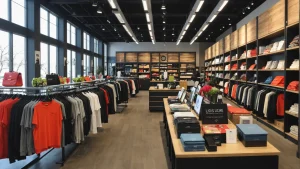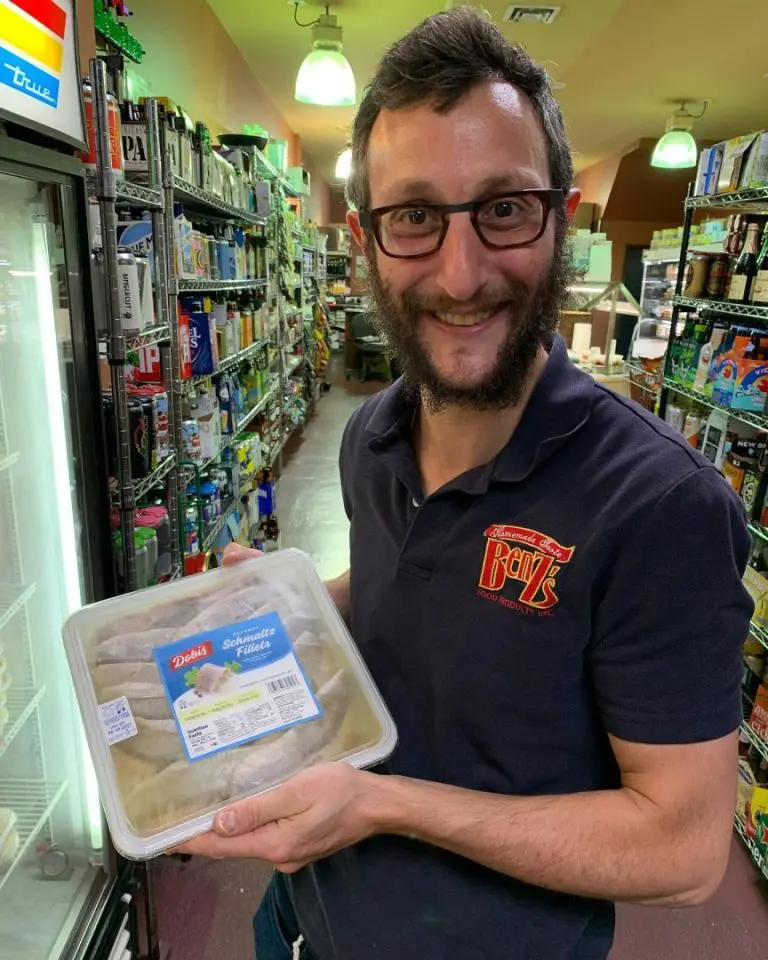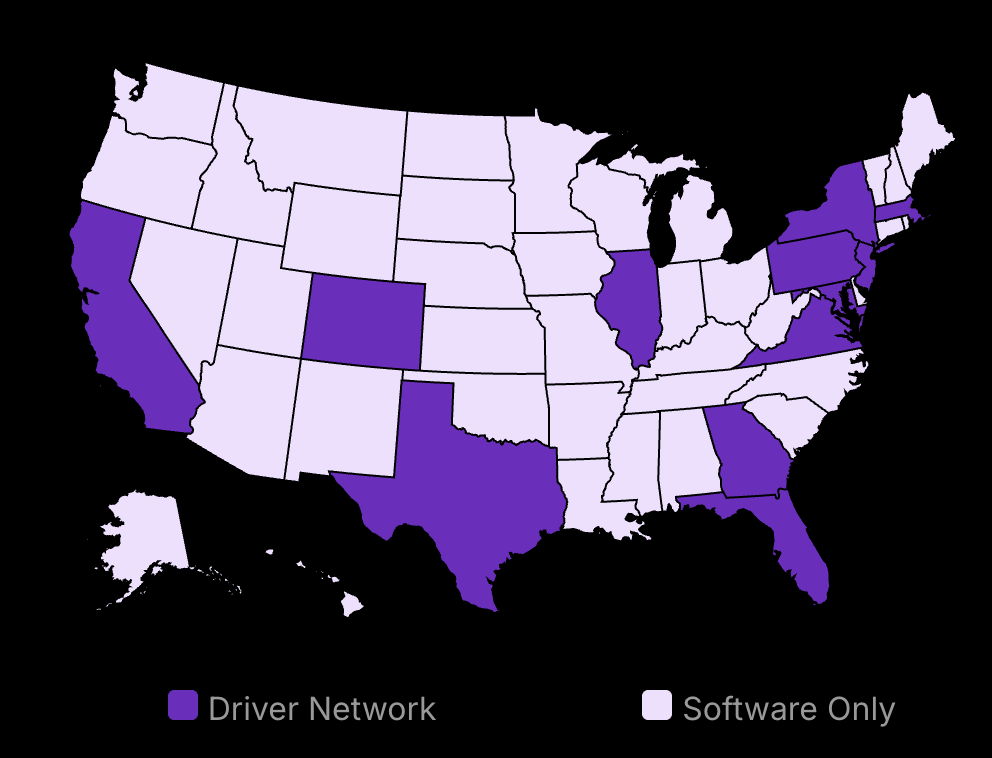Retail merchandising isn’t just about arranging products on shelves. It’s a tactic that can spike your sales and enhance customer experience.
Ever wondered why some stores catch your eye while others don’t?
This blog will guide you through retail merchandising, from its core definition to types like visual and digital merchandising tactics. We’ll look at examples from top retail chains and show how effective merchandising can influence shopping behavior. Ready to master this skill and boost your business?
Let’s jump in.

Save 80% of delivery management time
We handle everything:
- Dedicated operations manager
- Real-time tracking dashboard
- Automated customer notifications
- Urgent issue resolution
Definition of Retail Merchandising
-
Retail merchandising is all about pushing products for sale in retail spaces.
-
Focuses on how products look, their price, and keeping them in stock.
Retail merchandising forms the backbone of a store’s operations. It’s not just about putting items on shelves. It’s about presenting products in a way that entices customers and maximizes sales. This process includes choosing the right product mix, and pricing strategies, and ensuring products are available at the right time and place. A well-thought-out merchandising plan directly impacts a retailer’s sales and customer satisfaction. Discover effective tactics to enhance your store’s appeal and performance with these retail display strategies, effectively improving your store layout to captivate and retain more customers.
Most retailers adopt analytics to fine-tune their strategies based on customer behavior. These analytics help in crafting a seamless shopping experience, be it online or offline. Also, it is essential to integrate different retail channels. Stats show that 84% of consumers expect a better integration between online and offline channels. This integration creates a comprehensive shopping ecosystem, enhancing the customer’s overall experience.
Omnichannel Shopping
About 66% of consumers prefer omnichannel retailing experiences that combine both online and offline interactions.
Examples of Retail Merchandising
Retail merchandising varies across different brands, companies and industries. Take Walmart, for example. Known for its “everyday low prices,” Walmart uses strategic product placement and online marketing to draw customers. They rotate products based on seasons and leverage in-store displays to grab attention.
Here’s how you can look at retail merchandising at different levels:
Seasonal Promotions: These are sales events tied to seasons or specific holidays. For instance, during Christmas, stores deck their aisles with festive merchandise.
Product Placement: This involves putting popular products at eye level or near checkout counters to boost impulse buys.
An interesting approach to retail signage is seen in technology shops like Apple. Their stores are a visual treat. Clean lines, organized displays, and interactive setups let customers experience products firsthand. This creates a lasting impression and often leads to a purchase.
Action Items:
Observe a local store and note how products are arranged to attract buyers.
Try visiting a store during different seasons to see changes in product displays.
[Dive Deeper]:
Why We Buy: The Science of Shopping by Paco Underhill
“Retail Trends Don’t Change” Podcast
Types of Retail Store Merchandising
Retail merchandising mainly divides product merchandising into two categories: visual and digital. Each serves its own purpose and comes with its own techniques. Discover how seasonal merchandising strategies for small businesses can enhance both visual and digital displays, encouraging sales growth throughout the year.
Visual Merchandising Techniques
Visual merchandising involves how a store looks. It includes layout design, window displays, and interior decor. A great-looking store draws people in. For instance, store windows use bold themes and props to create stories. This leaves potential customers wanting more.
Layouts vary, from open and welcoming to more closed and intimate. These designs influence customer movement and buying behavior. Statistics suggest that an optimized store layout can increase sales by up to 15%.
Physical Stores Remain Vital
In-store sales represented approximately 85% of U.S. retail revenue in 2023, underscoring the continued importance of physical stores.
Action Items:
Test different store layouts and observe customer reactions.
Experiment with seasonal window themes to attract foot traffic.
[Dive Deeper]:
Silent Selling: Best Practices and Effective Strategies in Visual Merchandising by Judy Bell
Visual Merchandising Workshops online
Digital Merchandising
Digital merchandising gears towards online platforms. It means optimizing product listings, enhancing website visuals, and using digital ads effectively. Unlike traditional methods, digital merchandising services can be personalized based on user data. Platforms like Amazon utilize this by showing recommended items tailored to each visitor.
A Monthly Norm
79% of shoppers shop online at least once a month.
In-store vs. online? It really depends. In-store offers tactile experiences, while online provides convenience and personalization. Almost 40% of consumers buy more from retailers offering personalized shopping experiences across channels.
Online Research Drives Retail Sales
81% of retail shoppers conduct online research before making a purchase, highlighting the importance of digital presence for retailers.
Action Items:
Explore backend analytics for optimizing digital storefronts.
Use A/B testing for different layouts on eCommerce platforms.
[Dive Deeper]:
E-commerce: A Guide to Selling on the Internet by Denis Fred Simon
eCommerce MasterClass webinars
Retailers Invest More in Online Stores
Around 49% of retailers plan to increase their investment in their company-owned online stores, showing a shift towards enhancing digital platforms.
Type 1: Visual Merchandising Techniques
In visual merchandising, aesthetics is key. An appealing store design not only attracts customers but enhances their shopping experience. For instance, consider IKEA, whose store designs guide visitors through a creative maze of household setups. This encourages deeper exploration and increases total time spent in-store.
Layout Design involves the strategic arrangement of products. It’s crucial to direct customers to key areas and guide them effortlessly around the store.
Window Displays act like face value for stores. They have seconds to grab attention overwhelmed shoppers and need to be compelling.
Action Items:
Regularly update window themes.
Re-assess layout designs quarterly to align with seasonal changes.
[Dive Deeper]:
The Art of Visual Merchandising by Tony Morgan
Harvard Business School’s Retail Management Course – Check it out
Visual Merchandising Live Courses
Type 2: Effective Product Placement in Retail Stores
Effective product placement is about more than just stocking shelves. It’s about understanding consumer psychology. For instance, placing essentials far back in a store ensures customers pass other tempting products. This strategy is widely used in supermarkets and is a proven way to boost sales.
Shelf Positioning: Items at eye level often sell better. Consider Coca-Cola’s prime shelf spaces in grocery stores.
Point-of-Sale Areas: Placing small, enticing products near registers can boost impulse buys. Think about gum, small chocolates, and magazines—items you see last-minute at checkout.
Action Items:
Experiment with different shelf heights for product displays.
Use point-of-sale areas to promote exclusive deals or new products.
[Dive Deeper]:
Predictably Irrational: The Hidden Forces That Shape Our Decisions by Dan Ariely
In-Store Product Placement seminars
Each of these facets plays a crucial role in shaping a successful retail merchandising strategy. Exploring these will help anyone interested in store merchandising plan boosting both the aesthetics and effectiveness of their approach.
Benefits of Retail Merchandising
Drives sales through strategic product placement.
Enhances the overall shopping experience.
Personalizes interaction to build customer loyalty.
Boosts Sales Performance
Retail merchandising is all about putting products where customers can see them. It increases sales by making products more visible. Strategic placement means thinking about where items should sit on shelves so people notice them. Wallace Hopp, a prominent figure in operations management, highlights how layout optimization can also maximize sales and profits. Retailers often use promotions, like buy-one-get-one deals or discounts, to make certain products fly off the shelves. These strategies encourage customers to pick up items they weren’t planning to buy.
Enhances Customer Experience
Merchandising doesn’t just sell products; it makes shopping enjoyable. When a store is nicely arranged, customers find it easier and more pleasant to shop. This atmosphere gives them a reason to come back. An appealing environment can include streamlined pathways, clear signage, and engaging displays. Mickey Drexler once said that people like consistency when shopping. This consistency is created by maintaining a uniform shopping experience through layout and design. Pacific Northwest retailers like Nordstrom have artfully used ambiance in their merchandising to ensure customer comfort and satisfaction. They show that even when people don’t buy anything, a good experience will make them return.
Layout Design and Shopper Comfort
Store layout is more than just a blueprint; it’s a tool to make shopping smooth. A well-designed layout keeps customers in your store longer. This translates to more sales. When the layout feels intuitive, it reduces the stress of shopping. Tony Hsieh said that a brand thrives on the experience it delivers, not just on what it sells. Retailers like IKEA are well regarded for creating layouts that encourage discovery and provide a seamless flow from one product section to another. This has been shown to increase time spent in the store, which often leads to more purchases. For further insights into designing customer-friendly spaces, consider reading “Retail Design and Visual Merchandising” by Claudia D’Andrea.
Right-Side Traffic
Nearly 90% of shoppers tend to turn right upon entering a store, which is a critical insight for merchandising layout strategies.
Encourages Personalization
In a sea of options, personalization helps your brand stand out. Knowing customer preferences means you can tailor what they see first upon entering the store. Angela Ahrendts emphasizes personalization as a tool to break through the clutter. This can be done by analyzing customer data and offering personalized recommendations.
Online retailers like Amazon have mastered this with their suggestion algorithms, but brick-and-mortar stores can also utilize data to create an intimate shopping environment. For an academic dive into personalization techniques, “Predictive Analytics and Futurism” by Eric Siegel can be resourceful.
Fosters Strong Brand Identity
Merchandising is directly linked to the way people see and feel about a brand. Tory Burch has expressed that store design should be a brand’s extension, almost like welcoming someone into your home. This notion helps shape a strong and positive brand identity when carried into merchandising strategies. Examples from successful retail supply chains themselves, such as Apple with its minimalist aesthetics, showcase the critical role of design in merchandising. A strong brand identity appeals to the subconscious mind, creating familiarity and trust. Retailer case studies are found extensively in “The New Rules of Retail” by Robin Lewis.
Adapts to Market Trends
Staying updated with trends pays off. Retailers that adapt quickly to changes in consumer behavior keep customers interested. Understanding seasonal trends or shifts such as sustainability concerns can greatly influence how products are displayed and marketed. Paco Underhill notes that the retail industry is about creating experiences, which means retailers must continually change with consumer demands. This adaptability ensures relevance and alignment with consumer expectations. Books like “Retail Detail: A History of Visual Merchandising from Malevich to Mannequin” by Liza Bettaia offer historical context and insights into market adaptability.
By exploring these benefits, professionals can implement effective merchandising strategies that not only drive sales but also foster positive customer relationships, enhancing the overall shopping experience.
How Does Retail Merchandising Work?
-
Aligns stock with customer needs through constant monitoring.
-
Bridges in-store and purchasing teams for seamless operations.
-
Sharpens competitive edge with strategic market analysis.
Process Overview
Retail merchandising is a disciplined process involving a blend of art and analytics. At its core, merchandising requires constant monitoring of stock levels and product performance. Successful retailers don’t just put products on shelves; they understand the life cycle of a product and anticipate demand shifts. A key function is to maintain optimal stock levels to avoid shortages or excess. This involves using data to forecast demand and manage inventory effectively. Retailers must consider temporal factors, like upcoming holidays or seasonal shifts, to adjust stock accordingly.
Collaboration with purchasing teams is essential in ensuring that stock aligns with consumer demand trends. Merchandise planners communicate closely with buyers, ensuring that the products on the shelves match consumer expectations. They provide insight into what is selling, what isn’t, and what could sell next. Retailers achieve this by leveraging data analytics tools to assess past sales performance, predict future sales, and determine the right mix of products.
Retail Merchandiser’s Role
A retail merchandiser wears multiple hats. They are pivotal in creating an in-store experience that does more than sell—it engages and retains customers. Retail merchandisers often perform in-store product demonstrations. These demonstrations can significantly influence consumer behavior by showing the product’s value in real-time. They master visual merchandising to capture attention and create emotional connections with products.
Part of a merchandiser’s job description involves conducting competitive analyses. By understanding competitor offerings, pricing, and promotional activities, they can develop strategies that position their products favorably in the market. Competitor analysis allows merchandisers to anticipate market trends and adjust strategies accordingly. This proactive approach ensures that their store’s offerings remain relevant and appealing to customers.
Understanding the Duties and Responsibilities
Duties of a retail merchandiser encompass a wide spectrum. Beyond stock management and competitor analysis, merchandisers need to actively assess store displays and layout. These visual aspects play a crucial role in compelling consumers to purchase. Retailers can capture about 74% of shoppers who missed in-person shopping during the pandemic, by providing a more engaging in-store experience. Merchandisers aim to create an inviting in-store atmosphere, linking product placement with customer psychology.
Merchandisers also utilize retail audits as a tool for maintaining compliance with merchandising standards. Regular audits help identify areas needing improvement, allowing for real-time adjustments that can improve retail performance. They ensure that all sales floor merchandising efforts are aligned with the store’s objectives, maintaining consistency across all outlets.
Examples of Retail Merchandising Jobs
Retail merchandiser roles are often visible in well-known chains and small businesses alike. For instance, in a store like Target, a merchandiser might be seen setting up seasonal displays or overseeing high-demand product sections. A retail merchandiser maintains the health and appeal of various departments of retail business by regularly adjusting displays to attract shoppers.
Smaller retail businesses also value merchandisers for their strategic input. In these settings, merchandisers might focus more on niche products, ensuring that they resonate with the specific demographic frequenting the store. They might optimize small spaces to provide maximum visual impact, emphasizing unique selling points that differentiate them from larger competitors.
Diving into More Complex Aspects
Retail merchandising is not just about stocking and display. It extends into more nuanced territory, including understanding consumer psychology and enhancing customer experiences through personalized merchandising. To get deeper insights, consider exploring texts such as “Why We Buy: The Science of Shopping” by Paco Underhill, which discusses shopping behavior in the context of physical store environments. This book digs into consumer responses to retail space—knowledge that is vital for merchandisers looking to refine their strategies.
Merchandising is a field open to interpretation and innovation, leaving room for creative solutions alongside data-driven decisions. Those interested in exploring further should tap into reports and studies on consumer behavior trends or attend seminars and workshops focusing on advanced merchandising techniques to stay ahead.
How to Implement Effective Retail Merchandising Strategies
Step #1: Identify Target Audience
Identifying your target audience is crucial in retail merchandising. You can’t sell effectively if you don’t know who you’re talking to. Start by segmenting your customer base. Consider demographics like age, gender, and income level. Behavioral factors are vital, too, such as shopping habits and brand loyalty. Personalize your strategies to meet the preferences and needs of these groups.
Segment Customer Base
Break your audience into smaller groups. Look for patterns and common traits. Use tools like CRM systems to gather data. This can reveal customer behaviors, helping to create specific marketing campaigns for each segment.
Understand Buyer Behaviors
Analyzing buyer behavior informs your merchandising strategies. Pay attention to purchase history and feedback. Track what products they like and why. Engage with your customers through surveys or social media to know their preferences. Real-time data can enhance this understanding. Retailers using such data can reduce inventory costs by up to 15% and boost sales by 10%.
Step #2: Develop a Merchandising Plan
A well-crafted merchandising plan can align your sales goals with your inventory management needs. This step requires setting clear objectives. Focus on balancing sales targets with inventory turnover rates. This reduces the risk of overstocking or stockouts.
Set Objectives
Define what you aim to achieve. It could be increasing sales by a specific percentage or improving customer satisfaction scores. Objectives guide your actions and resonate with team efforts. Real-time analytics can offer insights to set more accurate targets. High-quality data benefits decision-making and avoids costly mistakes.
Plan Seasonal Promotions
Anticipate market trends and consumer needs for effective promotions. Highlight key products during holidays or special events. This attracts more customers to your shop in store front. Plan these promotions well in advance. Think about marketing channels you’ll use, such as emails or in-store signage.
Step #3: Use Visual Merchandising Techniques
Visual merchandising is about making your store visually appealing. It’s more than just colorful displays. Aim to create a captivating atmosphere that encourages spending.
Choose Color Schemes and Themes
Colors can influence buyers’ emotions and decisions. Pick schemes that align with your brand and the season. For instance, warm colors like red can evoke feelings of urgency, while cool colors like blue can calm the shopper, suggesting reliability.
Use Lighting Effectively
Lighting can highlight products and direct customer traffic. Use bright lights to focus on star products and dimmer lights for ambiance. Test different lighting styles to see what draws customer attention most effectively. It can be as critical as the product arrangement itself.
Step #4: Implement Dynamic Pricing
Dynamic pricing involves adjusting prices based on current market demands. You can change prices due to competitor pricing, customer demand, or inventory levels. This strategy ensures you’re competitive and maximize profit.
Use Analytics for Recommendations
Analytics tools can suggest optimal pricing points. They process real-time data to provide dynamic pricing insights, which can enhance profitability. Retailers who embrace such technology offer personalized services and highly localized assortments. This fosters a more engaging shopping experience.
Step #5: Regularly Analyze and Adjust
Merchandising is an ongoing process. Strategies need refining as trends change and customer preferences evolve. Analyze the outcomes of your strategies regularly.
Collect Feedback
Continuous feedback helps make timely improvements. Use store performance metrics and customer reviews for insights. Keeping an eye on foot traffic and sales data highlights what strategies work and which need adjustment.
Stay Flexible
Flexibility allows you to adapt rapidly. Markets are ever-changing, and a flexible approach keeps your store ahead. Utilize real-time insights to modify offerings and promotions timely, ensuring a seamless alignment with customer needs.
Test each of these steps in your store and tweak them to fit your unique business needs. The next section will build on these foundational strategies by offering practical tips for further display optimization.
3 Tips for In-Store Display Optimization
Tip #1: Keep Displays Fresh and Updated
Keeping your displays fresh means regularly changing the products on display. This tactic can increase consumer interest and lead to more sales. Let’s break this down into steps.
Step 1: Plan Regular Inventory Rotations
-
Schedule time to swap out older items for new arrivals. Stick to a rotation plan where you change displays every 2-3 weeks. New products attract attention.
-
Consider seasonal themes. Use seasons or holidays to plan rotations. Spring could mean floral displays, while winter might focus on cozy, warm items.
Step 2: Avoid Clutter in Displays
-
Stick to a central theme. Decide on a simple, clear theme for each display to draw attention to key products.
-
Limit items on display. More isn’t always better. Keep it neat. This means only showcasing a few top items. Consumers prefer a clean and organized look.
Step 3: Analyze Consumer Feedback
-
Use surveys and suggestion boxes. Your customer’s thoughts can help improve display effectiveness.
-
Test display performance. After each rotation, monitor sales figures to assess effectiveness.
Tip #2: Utilize Analytics for Decision Making
Using data from analytics takes the guesswork out of where to place your products. This can greatly improve your store layout and product sales.
Step 1: Collect Foot Traffic Data
-
Install sensors at store entrances. These give you valuable data on how customers move through your store.
-
Pay attention to high-traffic areas. These spots maximize product exposure.
Step 2: Analyze Sales Patterns
-
Use point-of-sale data. This tells you what sells best, and when. Keep an eye on which products are moving faster.
-
Compare sales with foot traffic data. Check if people are passing by displays but not purchasing. This indicates a need for change.
Step 3: Adapt Based on Interaction
-
Move low-performing displays. Try different spots in the store for products that aren’t doing well.
-
Use A/B testing for display variations. Test two different display setups to see which one performs better over some time.
Tip #3: Engage with Interactive Displays
Today’s consumers enjoy interactive experiences. Touchscreens and other digital elements can make your store displays engaging and informative.
Step 1: Integrate Touch Technology
-
Introduce tablets or kiosks. Let customers get detailed product info via interactive screens.
-
Provide QR codes. People scan these to learn more about the products in real time.
Step 2: Use Digital Screens for Promotions
-
Show videos and dynamic content. Rotate these often to keep content fresh.
-
Highlight promotions with interactive displays. This can be more compelling than traditional signage.
Step 3: Optimize Screen Placement
-
Position screens in areas with high foot traffic. Make sure they catch the attention of customers.
-
Ensure multiple clear sightlines. Customers should see and engage with screens easily from various angles.
By following these tips, your displays not only become more appealing but also enhance the in-store shopping experience. This approach can lead to an uptick in customer satisfaction and sales performance.
Ready to enhance your merchandising game? Let’s look at some strategies moving forward.
What is the Best Approach to Retail Merchandising?
Balancing Aesthetics and Economics
Achieving the right look for a retail space can attract more customers, but it’s crucial to find a balance between aesthetics and budget. Using materials that look good but aren’t expensive is a clever way to manage costs. This approach offers the chance to create environments that are visually appealing without draining resources.
Consistency and Visual Appeal
Consistency in visual presentation is a key factor. Customers like to be wowed by a store’s design, but more than anything, they seek something familiar and reliable. To them, consistency signals professionalism. Mickey Drexler once pointed out, “People like consistency. Whether it’s a store or a restaurant, they want to come in and see what you are famous for.” Thinking in this way can help create brand recognition.
Cost-Effective Displays
Creating cost-effective retail displays is not always about using the cheapest materials but finding a way to replicate an upscale feel cost-effectively. Tory Burch shared a perspective that is useful for retailers aiming for authenticity: “My company is an extension of me, so when I designed my stores, I wanted people to feel that they were in my home.” This creates a comfortable atmosphere and encourages loyalty, without overspending.
Leveraging Technology
Today’s tech can transform the shopping experience. It allows for the personalization that customers now expect from modern retail stores. Leveraging tech such as AI and CRM systems can support both backend operations and frontend experiences, making shopping smoother and more engaging.
AI for Personalized Customer Experiences
Machine learning tools can assess shopper data in real-time to offer personalized recommendations. This approach not only showcases products more effectively but also strengthens relationships with customers. Angela Ahrendts, a well-regarded businesswoman, noted, “Personalization is the key to cutting through the noise and making a meaningful connection with customers.”
CRM for Targeted Marketing
CRM systems provide valuable insights into customer habits and preferences. Moving beyond broad marketing schemes, targeted efforts can be informed by CRM data to offer personalized promotions and deals. This approach aligns with Paco Underhill’s view that “Retail is no longer about just selling products; it’s about creating experiences.”
The Average Cost of a Retail Lead
The average cost for a retail lead is approximately $34, indicating rising expenses associated with customer acquisition.
Enabling Customer Engagement
Connecting with customers goes beyond the point of purchase. Retailers need to create fulfilling shopping experiences. Enhancing customer experiences encourages loyalty. Not just physical items, but how people feel while shopping plays a vital role in shaping brand identity.
Experiential Shopping
It’s now about crafting immersive and fun shopping experiences. Interactive elements, like digital kiosks or VR experiences, invite customers to engage with products in creative ways. Tony Hsieh noted, “Your brand is not what you sell; it’s the experience you deliver.” Opportunities to probe different aspects of products are what keep customers coming back.
High-Quality Service
Customer interactions shouldn’t end after the product is bagged. The way staff communicates, the support offered post-purchase—all of these elements make for high-quality experiences that encourage repeat visits. Phillip Green emphasized the importance of this by observing, “People are always going to go shopping. A lot of our effort is just ‘how do we make the retail experience a great one?”
Exploring books like “Why We Buy” by Paco Underhill can offer deeper insights into retail behavior. To continue learning, you might explore consumer behavior journals, delve into experiential marketing strategies, or even look into personalization in other fields like online retail.
In the retail sector, these methods are profound but complex. They incorporate advanced marketing and consumer psychology, requiring ongoing learning for mastery.
Making Every Inch Count
Retail merchandising involves more than just setting up products. It’s about combining product placement, visual appeal, and customer insights to drive sales and enhance the shopping experience. Consider how your brick-and-mortar store front’s layout affects foot traffic. Develop a plan that aligns with your target audience. Look for tech tools that offer customer insights. What changes can you make today to transform your merchandising strategy? Making small adjustments might just boost your sales more than you expect.



























